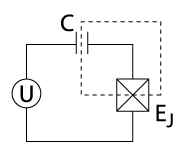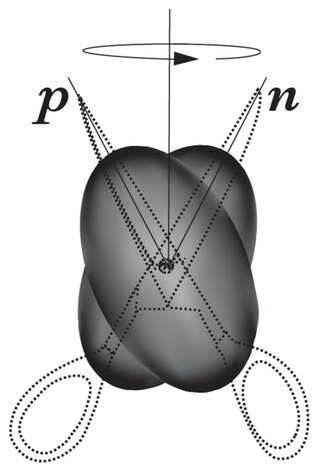Related Research Articles

In quantum computing, a charge qubit is a qubit whose basis states are charge states. In superconducting quantum computing, a charge qubit is formed by a tiny superconducting island coupled by a Josephson junction to a superconducting reservoir. The state of the qubit is determined by the number of Cooper pairs which have tunneled across the junction. In contrast with the charge state of an atomic or molecular ion, the charge states of such an "island" involve a macroscopic number of conduction electrons of the island. The quantum superposition of charge states can be achieved by tuning the gate voltage U that controls the chemical potential of the island. The charge qubit is typically read-out by electrostatically coupling the island to an extremely sensitive electrometer such as the radio-frequency single-electron transistor.

Mott insulators are a class of materials that are expected to conduct electricity according to conventional band theories, but turn out to be insulators. These insulators fail to be correctly described by band theories of solids due to their strong electron–electron interactions, which are not considered in conventional band theory. A Mott transition is a transition from a metal to an insulator, driven by the strong interactions between electrons. One of the simplest models that can capture Mott transition is the Hubbard model.
Extremal optimization (EO) is an optimization heuristic inspired by the Bak–Sneppen model of self-organized criticality from the field of statistical physics. This heuristic was designed initially to address combinatorial optimization problems such as the travelling salesman problem and spin glasses, although the technique has been demonstrated to function in optimization domains.
Oleg Sushkov is a professor at the University of New South Wales and a leader in the field of high temperature super-conductors. Educated in Russia in quantum mechanics and nuclear physics, he now teaches in Australia.
Jozef T. Devreese is a Belgian scientist, with a long career in condensed matter physics. He is Professor Emeritus of Theoretical Physics at the University of Antwerp.

In condensed matter physics, a string-net is an extended object whose collective behavior has been proposed as a physical mechanism for topological order by Michael A. Levin and Xiao-Gang Wen. A particular string-net model may involve only closed loops; or networks of oriented, labeled strings obeying branching rules given by some gauge group; or still more general networks.
Atomtronics is the emerging quantum technology of matter-wave circuits which coherently guide propagating ultra-cold atoms. The systems typically include components analogous to those found in electronic or optical systems, such as beam splitters and transistors. Applications range from studies of fundamental physics to the development of practical devices.
The topological entanglement entropy or topological entropy, usually denoted by , is a number characterizing many-body states that possess topological order.
Quantum dimer models were introduced to model the physics of resonating valence bond (RVB) states in lattice spin systems. The only degrees of freedom retained from the motivating spin systems are the valence bonds, represented as dimers which live on the lattice bonds. In typical dimer models, the dimers do not overlap.
Subir Sachdev is Herchel Smith Professor of Physics at Harvard University specializing in condensed matter. He was elected to the U.S. National Academy of Sciences in 2014, and received the Lars Onsager Prize from the American Physical Society and the Dirac Medal from the ICTP in 2018. He was a co-editor of the Annual Review of Condensed Matter Physics from 2017-2019.
In statistical mechanics, the metastate is a probability measure on the space of all thermodynamic states for a system with quenched randomness. The term metastate, in this context, was first used in by Charles M. Newman and Daniel L. Stein in 1996..

David R. Nelson is an American physicist, and Arthur K. Solomon Professor of Biophysics, at Harvard University.
Eric R. Weeks is an American physicist. He completed his B.Sc. at the University of Illinois at Urbana–Champaign in 1992. He obtained a Ph.D. in physics from the University of Texas at Austin in 1997, working under Harry Swinney, and later completed post-doctoral research with David Weitz and Arjun Yodh at Harvard University and the University of Pennsylvania. He is currently a full professor at Emory University in Atlanta, Georgia.

Michael Elmhirst Cates is a British physicist. He is the 19th Lucasian Professor of Mathematics at the University of Cambridge and has held this position since 1 July 2015. He was previously Professor of Natural Philosophy at the University of Edinburgh, and has held a Royal Society Research Professorship since 2007.

Scissors Modes are collective excitations in which two particle systems move with respect to each other conserving their shape. For the first time they were predicted to occur in deformed atomic nuclei by N. LoIudice and F. Palumbo, who used a semiclassical Two Rotor Model, whose solution required a realization of the O(4) algebra that was not known in mathematics. In this model protons and neutrons were assumed to form two interacting rotors to be identified with the blades of scissors. Their relative motion (Fig.1) generates a magnetic dipole moment whose coupling with the electromagnetic field provides the signature of the mode.
James (Jim) P. Eisenstein is the Frank J. Roshek Professor of Physics and Applied Physics at the physics department of California Institute of Technology.
Giovanni Vignale is an Italian American physicist and Professor of Physics at the University of Missouri. Vignale is known for his work on density functional theory - a theoretical approach to the quantum many-body problem - and for several contributions to many-particle physics and spintronics. He is also the author of a monograph on the "Quantum Theory of the Electron Liquid" and a book entitled "The Beautiful Invisible - Creativity, imagination, and theoretical physics".

Carlos O. Lousto is a Professor in the School of Mathematical Sciences in Rochester Institute of Technology, known for his work on black hole collisions.
Bogdan Andrei Bernevig is a Romanian Quantum Condensed Matter Professor of Physics at Princeton University and the recipient of the John Simon Guggenheim Fellowship in 2017.
In statistical mechanics and condensed matter physics, the Kovacs effect is a kind of memory effect in glassy systems below the glass-transition temperature. A.J. Kovacs observed that a system’s state out of equilibrium is defined not only by its macro thermodynamical variables, but also by the inner parameters of the system. In the original effect, in response to a temperature change, under constant pressure, the isobaric volume and free energy of the system experienced a recovery characterized by non-monotonic departure from equilibrium, whereas all other thermodynamical variables were in their equilibrium values. It is considered a memory effect since the relaxation dynamics of the system depend on its thermal and mechanical history.
References
- ↑ Palmer, R. G.; Stein, D. L.; Abrahams, E.; Anderson, P. W. (1984-09-03). "Models of Hierarchically Constrained Dynamics for Glassy Relaxation". Physical Review Letters. American Physical Society (APS). 53 (10): 958–961. Bibcode:1984PhRvL..53..958P. doi:10.1103/physrevlett.53.958. ISSN 0031-9007.
- ↑ Stein, D. L. (1985-06-01). "A model of protein conformational substates". Proceedings of the National Academy of Sciences. 82 (11): 3670–3672. Bibcode:1985PNAS...82.3670S. doi: 10.1073/pnas.82.11.3670 . ISSN 0027-8424. PMC 397848 . PMID 16593568.
- ↑ Maier, Robert S.; Stein, D. L. (1993-09-20). "Effect of focusing and caustics on exit phenomena in systems lacking detailed balance". Physical Review Letters. 71 (12): 1783–1786. arXiv: chao-dyn/9305010 . Bibcode:1993PhRvL..71.1783M. doi:10.1103/physrevlett.71.1783. ISSN 0031-9007. PMID 10054499. S2CID 8016923.
- ↑ Bürki, J.; Stafford, C. A.; Stein, D. L. (2005-08-22). "Theory of Metastability in Simple Metal Nanowires". Physical Review Letters. 95 (9): 090601. arXiv: cond-mat/0505221 . Bibcode:2005PhRvL..95i0601B. doi:10.1103/physrevlett.95.090601. ISSN 0031-9007. PMID 16197198. S2CID 12675391.
- ↑ Martens, Kirsten; Stein, D. L.; Kent, A. D. (2006-02-10). "Magnetic reversal in nanoscopic ferromagnetic rings". Physical Review B. 73 (5): 054413. arXiv: cond-mat/0410561 . Bibcode:2006PhRvB..73e4413M. doi:10.1103/physrevb.73.054413. ISSN 1098-0121. S2CID 93933.
- ↑ Newman, C. M.; Stein, D. L. (1996-01-15). "Non-Mean-Field Behavior of Realistic Spin Glasses". Physical Review Letters. American Physical Society (APS). 76 (3): 515–518. arXiv: adap-org/9508006 . Bibcode:1996PhRvL..76..515N. doi:10.1103/physrevlett.76.515. ISSN 0031-9007. PMID 10061476. S2CID 12238236.
- ↑ Newman, C M; Stein, D L (2003-08-01). "Ordering and broken symmetry in short-ranged spin glasses". Journal of Physics: Condensed Matter. IOP Publishing. 15 (32): R1319–R1364. arXiv: cond-mat/0301403 . doi:10.1088/0953-8984/15/32/202. ISSN 0953-8984. S2CID 16403161.
- ↑ Newman, C. M.; Stein, D. L. (1997-05-01). "Metastate approach to thermodynamic chaos". Physical Review E. American Physical Society (APS). 55 (5): 5194–5211. arXiv: cond-mat/9612097 . Bibcode:1997PhRvE..55.5194N. doi:10.1103/physreve.55.5194. ISSN 1063-651X. S2CID 14821724.
- ↑ "Daniel L. Stein". Santa Fe Institute . Archived from the original on 2010-05-27. Retrieved 2010-02-02.
- ↑ "Home". aspenphys.org.
- ↑ "Despite Financial Crisis, Dramatic Shift Expected in U.S. S&T Policy". AAAS News & Notes. Archived from the original on 2010-02-10. Retrieved 2010-02-05.
- ↑ "Daniel L. Stein". John Simon Guggenheim Memorial Foundation. Archived from the original on 2014-07-15. Retrieved 2014-07-10.